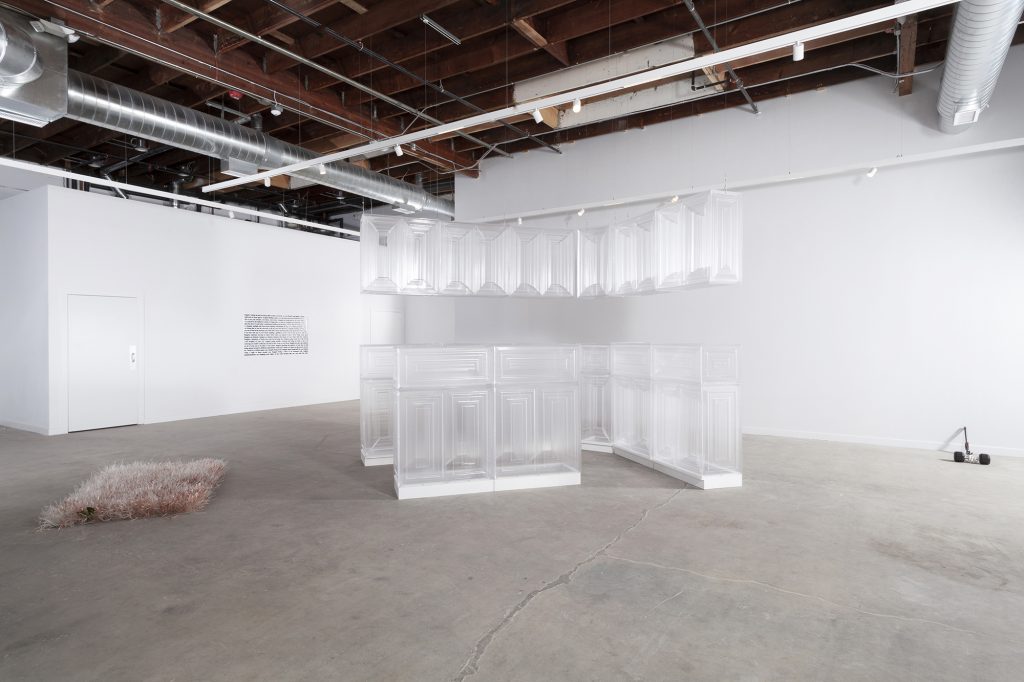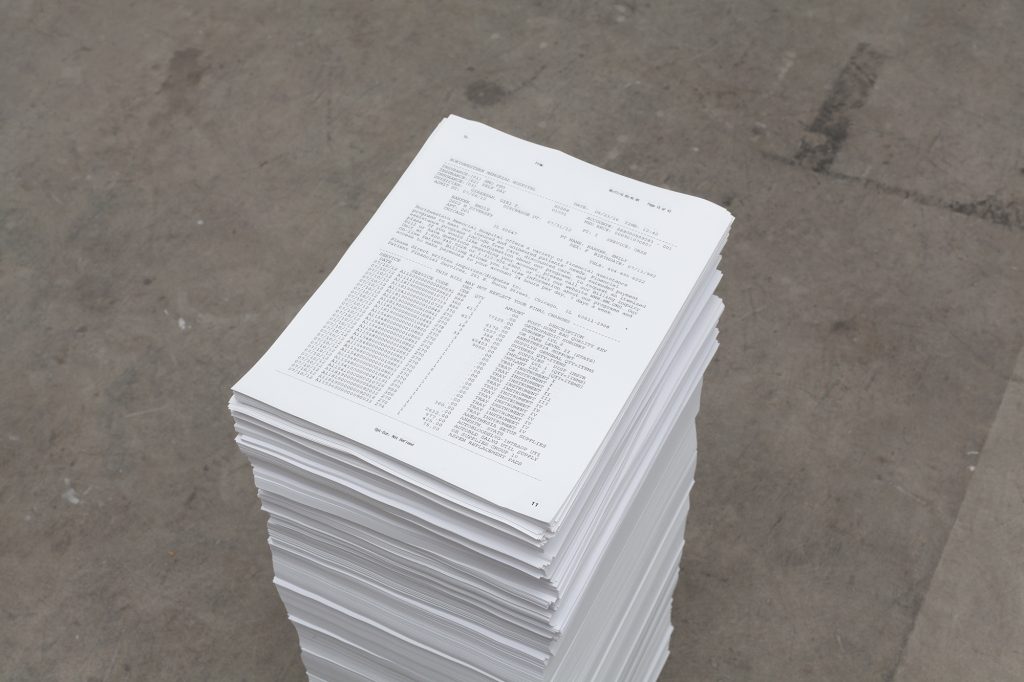Kitchen cabinetry is often built to prioritize a certain body. Architectural standards dictate that they are nearly always installed using set spatial proportions most optimal for someone five feet and nine inches tall. By overlooking the specificity of space and people, construction and ultimately reproduction becomes simple. In its wake, a specific able-bodied archetype comes to represent the typical. Haunting this line of thinking is the belief that when those in power set standards, they do what is most sensical, and something sensical is entitled to faith and trust. Between blindly accepting the instituted and parsing through the feelings and sensations that come up concomitantly with your environment, there is room for friction. Emily Barker’s exhibition, Built to Scale, which ran from December 14 to January 18, 2020, offers space for experiencing accessibility as a collective and collaboratively made endeavor.

Murmurs houses their 1,600 square foot gallery in a converted industrial garage of downtown Los Angeles. It is a cleanly kept, white-walled room with two ADA accessible restrooms (built up to code with the Americans with Disabilities Act) that offers ample clearance for folks using mobility devices. Like the freshly remodeled space, Barker’s work has a seamlessness to it that bears the mark of mechanized production. ‘Untitled (Kitchen)’ occupies the center of the site; translucent plastic thermoformed cabinetry has been arranged and scaled to parody a domestic cooking space. Barker’s model is much taller than usual, situating able bodies at a perspective that wheelchair users regularly face in spaces where accessibility is an afterthought. The installation is a vague and austere copy of the real thing. It provides just enough familiarity for viewers to reassociate their experience of a conventional iteration of scale. In addressing the structures’ inaccessibility by adjusting its height, the impulse to locate a unified problem or solution becomes troubled. It is not simply that a wheelchair is too low or that the counter is too unmoveable. What aches for negotiation is the obscured reality that design and the collective inform each other, and whether we like it or not, design comes with an ethical proposition.
Throughout Built to Scale, familiar objects have had their conventional modes of use turned back on themselves. Along the gallery’s perimeter, a wooden closet rod—as its title ‘Out of Reach’ suggests—hangs too high for anyone to access. A baby blue butterfly night light glows out of the power outlet beneath it, attempting to provide a softness to the sterile exhibition space. A diamond plated thermoformed plastic ramp too steep for anyone to access leads into a wall. Pieces of Barker’s old wheelchair, broken from maneuvering inaccessible domestic and public spaces, lay beneath.

The positioning of most of the pieces allows for smooth movement through Murmurs. However, a handwoven sculpture resembling a rug made of plastic IV tubing, copper electrical wire, a doggie bag, headphones, and a shoelace rests on the floor easily in your line of step. Rugs are a floor feature often overlooked as a barrier for folks using mobility devices. In the weeks leading up to Built to Scale, friends helped weave together the piece as they gossiped and discussed the upcoming US election. Barker called it a knitting circle. The memory of the many different hands involved in the piece’s creation reverberates in the eccentricities of its pattern. The artist says, part of living with their disability means relying on friends to provide care where health services fall short, which ultimately means many of their needs go unmet. Like the rug, much of Barker’s livelihood is tied to the collaborative support it takes to enable their mobility in the world.
A sound track shifts through discreet wall speakers from a small room within the gallery. It blends in with the echoes of shoes leisurely moving through the space. Feedback, choral voices, a phone operator, and the familiar reverberating claps and funky melody from ‘Opus 1’ (the Cisco CallManager default hold music) fade in and out over the 10 minute audio piece made in collaboration with artist Emily Lucid. The composition is shrill, amorphous and recursive, but Lucid’s vocals ground the work in an emotionality and aesthetic sensitivity that permeates the rest of the exhibition. In the center of the fluorescent-lit space is a 7,865 sheet stack of xeroxed medical bills and health care plan that outlines the monetary value of Barker’s life (totaling around $600,000, according to the press release). The artist’s tendency toward drawing on the personal to establish a critical dialogue is a way of working that makes their identity apparent as opposed to vague or essentially anonymous. This feels marked by a political context in which people have access to seeing under the veil of ideology but do not readily mobilize toward radical action in a traditional sense. Instead, they tend toward examining the structures at work in their internal worlds and immediate community.

Hanging at ‘standard’ eye-level is a block of prose titled ‘Hierarchy of Needs’. The texts offers context for those that might have skipped the press release or do not recognize Barker’s candidness from their social media presence or The Death Panel podcast they cohost. ‘Hierarchy of Needs’ feels motivated by an urge to direct readers back to an empathic and experiential space. The typeface is blurry and hard to read but with some extra effort, it is legible:
“Imagine waking up and not being able to enter your house or your friends and family’s home or the bathrooms in those spaces… imagine an obstacle built into every object built into existence… imagine being a light to those around you. Imagine being a force to be reckoned with.”
Through the exhibition itself, the press release, and the artist’s own words via social media, Barker’s imperative becomes emphatically clear. They want to disturb the unchecked expectations that enable a system that restricts disabled bodies’ efforts to live. Built to Scale activates its viewers’ experiential capacities to establish critical dialogue around accessibility, where a data set or news article might fall short. Experience, in a metaphysical sense, is treated as an ongoing and essentially discursive project. Built to Scale’s stands in opposition to the practice of taking refuge in established standards and justifying it by virtue of a presupposed neutrality.**
Emily Barker’s Built to Scale solo exhibition was on at Los Angeles’ Murmurs, running December 14 to January 18, 2020.













